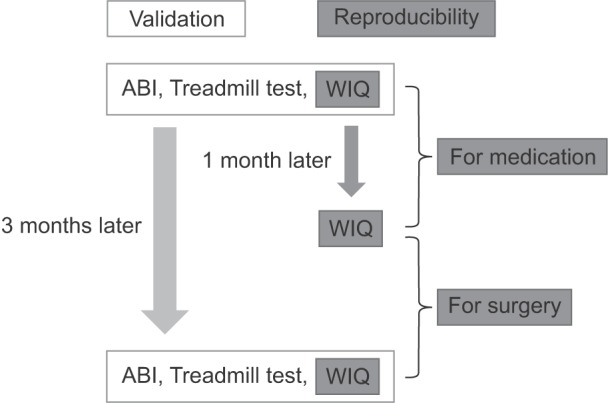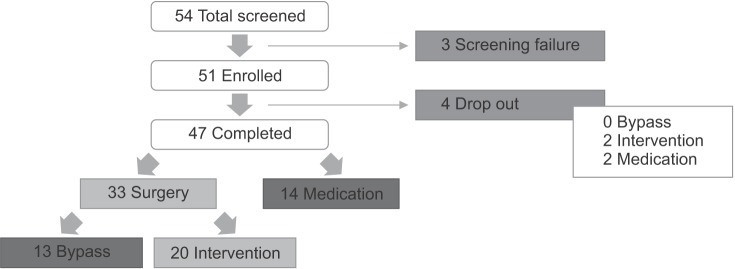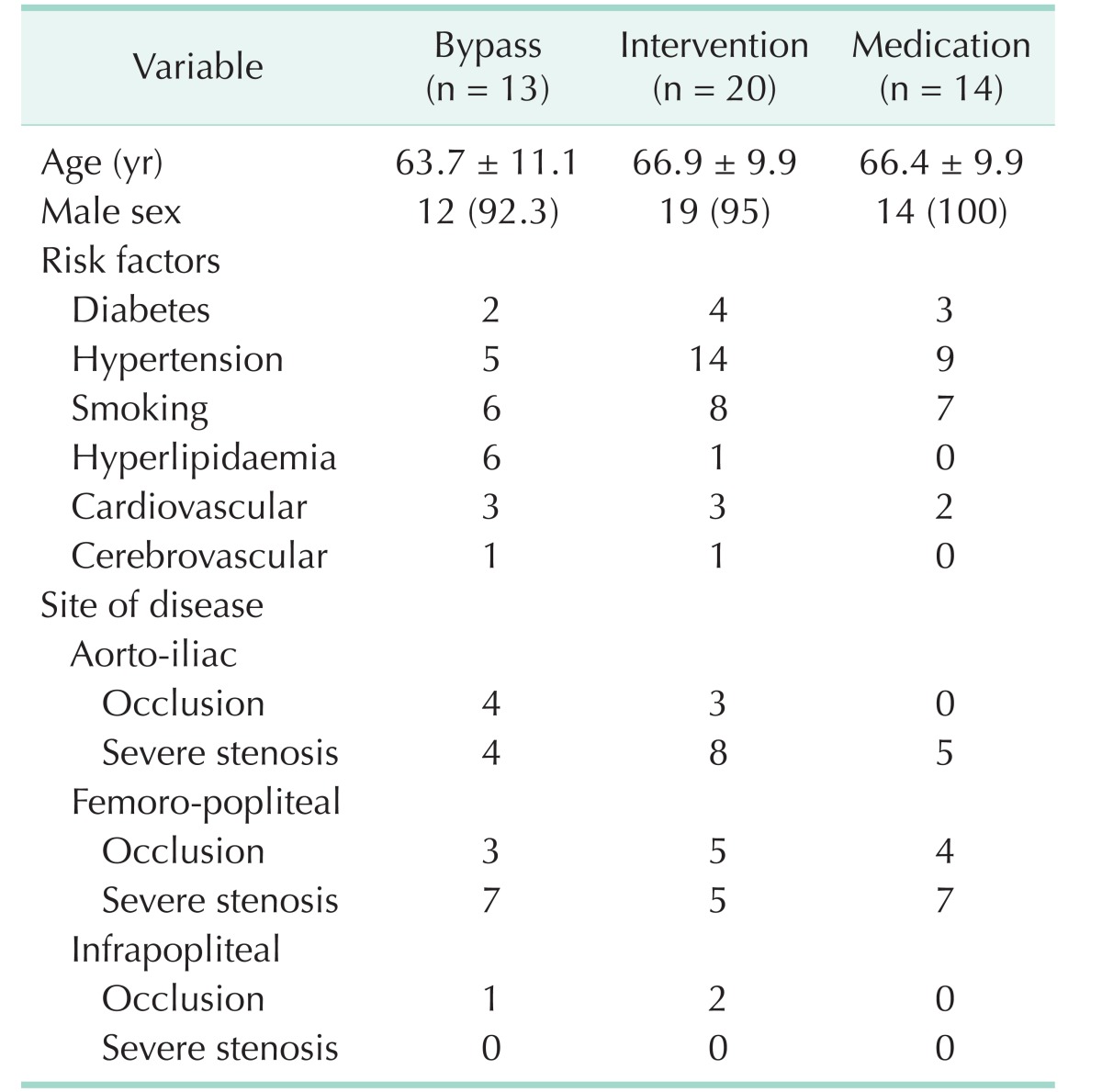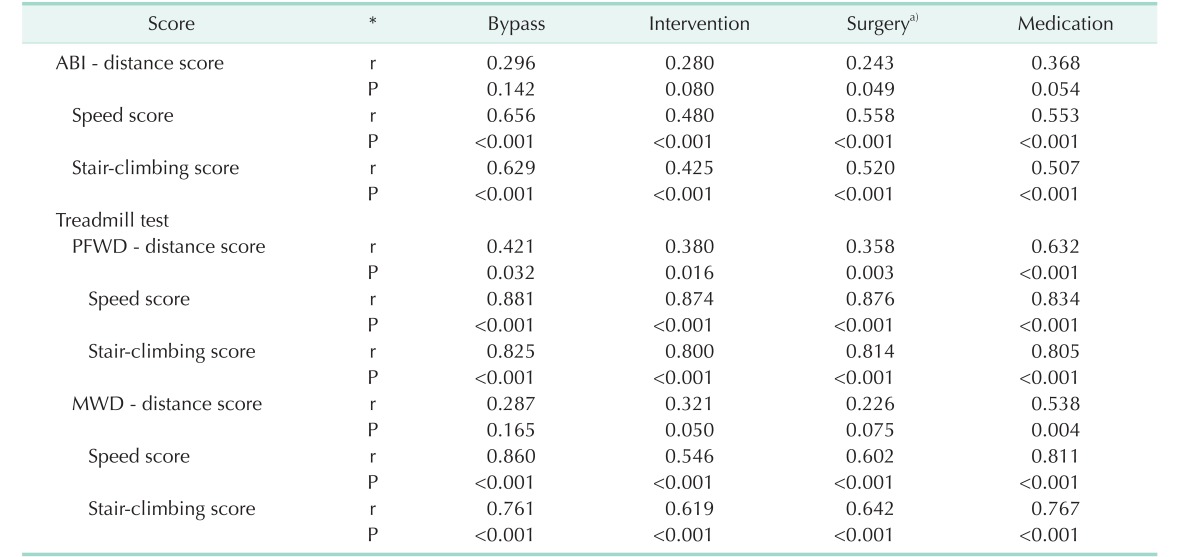1. Malgor RD, Alahdab F, Elraiyah TA, Rizvi AZ, Lane MA, Prokop LJ, et al. A systematic review of treatment of intermittent claudication in the lower extremities. J Vasc Surg. 2015; 61(3 Suppl):54S–73S. PMID:
25721067.

2. Schorr EN, Treat-Jacobson D. Methods of symptom evaluation and their impact on peripheral artery disease (PAD) symptom prevalence: a review. Vasc Med. 2013; 18:95–111. PMID:
23509087.

3. Rose GA, Blackburn H. Cardiovascular survey methods. Monogr Ser World Health Organ. 1968; 56:1–188.
4. Rose G, McCartney P, Reid DD. Self-administration of a questionnaire on chest pain and intermittent claudication. Br J Prev Soc Med. 1977; 31:42–48. PMID:
856370.

5. Leng GC, Fowkes FG. The Edinburgh Claudication Questionnaire: an improved version of the WHO/Rose Questionnaire for use in epidemiological surveys. J Clin Epidemiol. 1992; 45:1101–1109. PMID:
1474406.
6. Criqui MH, Denenberg JO, Bird CE, Fronek A, Klauber MR, Langer RD. The correlation between symptoms and noninvasive test results in patients referred for peripheral arterial disease testing. Vasc Med. 1996; 1:65–71. PMID:
9546918.

7. EuroQol Group. EuroQol: a new facility for the measurement of health-related quality of life. Health Policy. 1990; 16:199–208. PMID:
10109801.
8. Brooks R. EuroQol: the current state of play. Health Policy. 1996; 37:53–72. PMID:
10158943.

9. Frendl DM, Ware JE Jr. Patient-reported functional health and well-being outcomes with drug therapy: a systematic review of randomized trials using the SF-36 health survey. Med Care. 2014; 52:439–445. PMID:
24714581.
10. Hiatt WR, Rogers RK, Brass EP. The treadmill is a better functional test than the 6-minute walk test in therapeutic trials of patients with peripheral artery disease. Circulation. 2014; 130:69–78. PMID:
24982118.

11. Regensteiner JG, Steiner JF, Panzer RJ, Hiatt WR. Evaluation of walking impairment by questionnaire in patients with peripheral arterial disease. J Vasc Med Biol. 1990; 2:142–152.
12. Hiatt WR, Hirsch AT, Regensteiner JG, Brass EP. Clinical trials for claudication. Assessment of exercise performance, functional status, and clinical end points. Vascular Clinical Trialists. Circulation. 1995; 92:614–621. PMID:
7634476.
13. Norgren L, Hiatt WR, Dormandy JA, Nehler MR, Harris KA, Fowkes FG, et al. Inter-Society Consensus for the Management of Peripheral Arterial Disease (TASC II). Eur J Vasc Endovasc Surg. 2007; 33(Suppl 1):S1–S75. PMID:
17140820.

14. Verspaget M, Nicolaï SP, Kruidenier LM, Welten RJ, Prins MH, Teijink JA. Validation of the Dutch version of the Walking Impairment Questionnaire. Eur J Vasc Endovasc Surg. 2009; 37:56–61. PMID:
19008127.

15. Wohlgemuth WA, Niechzial M, Nagel E, Bohndorf K. Assessment of the quality of life of patients with peripheral vascular diseases. Rofo. 2003; 175:169–175. PMID:
12584614.
16. Schiano V, Brevetti G, Sirico G, Silvestro A, Giugliano G, Chiariello M. Functional status measured by walking impairment questionnaire and cardiovascular risk prediction in peripheral arterial disease: results of the Peripheral Arteriopathy and Cardiovascular Events (PACE) study. Vasc Med. 2006; 11:147–154. PMID:
17288120.
17. Lozano FS, March JR, González-Porras JR, Carrasco E, Lobos JM, Areitio-Aurtena A. Validation of the Walking Impairment Questionnaire for Spanish patients. Vasa. 2013; 42:350–356. PMID:
23989070.

18. Sigvant B, Lundin F, Nilsson B, Bergqvist D, Wahlberg E. Differences in presentation of symptoms between women and men with intermittent claudication. BMC Cardiovasc Disord. 2011; 11:39. PMID:
21718516.

19. Matsuo H, Shigematsu H. Patient-based outcomes using the Walking Impairment Questionnaire for patients with peripheral arterial occlusive disease treated with Lipo-PGE1. Circ J. 2010; 74:365–370. PMID:
20037256.

20. Yan BP, Lau JY, Yu CM, Au K, Chan KW, Yu DS, et al. Chinese translation and validation of the Walking Impairment Questionnaire in patients with peripheral artery disease. Vasc Med. 2011; 16:167–172. PMID:
21636675.
21. Beaton DE, Bombardier C, Guillemin F, Ferraz MB. Guidelines for the process of cross-cultural adaptation of selfreport measures. Spine (Phila Pa 1976). 2000; 25:3186–3191. PMID:
11124735.

22. Jie Wang, Yan Cui, Bian RW, Mo YZ, Haidi Wu, Ling Chen. Validation of the Chinese version of the Walking Impairment Questionnaire in patients with both peripheral arterial disease and type 2 diabetes mellitus. Diab Vasc Dis Res. 2011; 8:29–34. PMID:
21262868.
23. Lee JH, Cho KI, Spertus J, Kim SM. Crosscultural adaptation and validation of the Peripheral Artery Questionnaire: Korean version for patients with peripheral vascular diseases. Vasc Med. 2012; 17:215–222. PMID:
22653880.






 PDF
PDF ePub
ePub Citation
Citation Print
Print







 XML Download
XML Download